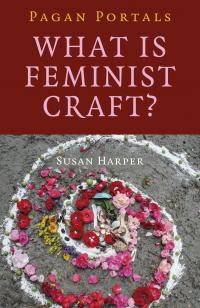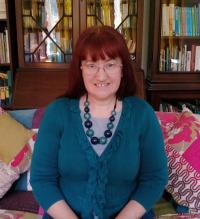
Feminist Craft – Susan Harper
Chapter 1: Foundations - Why Feminism? Why Witchcraft? Why Feminist Witchcraft?
If you’ve picked up this book, it’s likely you’ve read more than one introduction to Wicca or other forms of Witchcraft, and you’re likely asking yourself what makes Feminist Witchcraft different than all of those you’ve read about before. In truth, there are many overlaps with the Feminist Witchcraft I practice and other forms of Witchcraft and Contemporary Pagan spirituaity and magickal practice. But there are also a few things that set it apart, and it is these specific characteristics that drew me to the practice of Feminist Witchcraft rather than just the electic Wicca that is far more common in my Pagan and magickal community. I jokingly say that I came for the transcendence and stayed for the politics, but there’s more than a grain of truth in that jest. I was drawn to Feminist Witchcraft becuase it made explicit the connection between power and resistance, between transformation in the spiritual world and social change in the physical world, and between the personal and the collective. It was the first overtly political form of spiritual practice I’d encountered -- or at least the first one that centered politics that mirrored my own. While I believe that all Witchcraft is at its heart political, choosing to practice a Craft that is intrinsically rooted in feminist politics is what feels most authentic for me.
A Quick Note on Terminology
Throughout this book, there are several terms I will use somewhat interchangeably for the type of Witchcraft I am talking about. I will refer to it variously as Feminist Witchcraft, Feminist Craft, or (sometimes, rarely) Goddess Craft. You will also encounter the terms Feminist Spirituality, Women’s Spirituality, and Goddess Spirituality as you make your way through these chapters, particularly when I discuss historical foundations of Feminist Witchcraft in the United States and other areas of the West. Each of these terms has its own subtle shades of meaning, and I tend to move back and forth among them. The exception is Women’s Spirituality, which I only use when discussing the historical underpinnings of Feminist Craft, because I do not believe that the practice of Feminist Witchcraft needs to be limited to cisgender women alone -- one of the places I differ strongly with the founders of the Feminist Witchcraft movement in the US, as we will explore later.
Throughout this book, I will use the term women to refer to both cisgender and transgender women -- trans women are always included when I speak about women. In cases where the distinction matters, as in discussions of exclusion of trans women or the founding mothers of Feminist Craft limiting their definition of womanhood to cisgender women, I will use more precise language or will add footnotes for clarification. I also at times us the term “non-men” to refer to people who are not women but who are also not men -- nonbinary people, genderfluid people, and agender people, among others. This language is imperfect but is at the time of this writing the best solution I can come up with to work around the binary nature of English terms for gender.
The Dreaded F Word
So let’s get the dreaded F-word out of the way, shall we?
A full explanation of everything feminism is (and isn’t) would require this book to be twice as long, and even then would probably be incomplete. For our purposes here, I’ll distill feminism as I understand and practice it down a bit, and I also encourage those of you who want a more in-depth discussion to explore the resources at the end of this book.
Simply put, feminism as I understand and practice it is a social movement for equality, equity, and justice for all people regardless of gender, sexual orientation, race, ethnicity, class, dis/ability, or other social status. Feminism is the idea that there is no such thing as a lesser person, that all people deserve equality, equity, justice, and dignity. I know what some of you are thinking: Why not call it humanism or equalism? Well, humanism already applies to another social movement -- one in which people believe that humans do not need gods or divine beings to guide them or give them meaning. (Many humanist beliefs are indeed feminist and otherwise pro-equality, but the word has other important meanings as well.) Equalism is a term that’s often used by people who actually want to deny that inequality exists or to assert that all people share the same level of oppression, and thus specific movements for gender, racial, disability, or queer justice are no longer needed. Neither is satisfactory to me. I prefer the word (and the concept) of feminism because it foregrounds gender as an axis of oppression, and for me -- a white, bisexual, cisgender (*), enabled woman -- it is the axes of gender and sexual orientation that have been the primary sites of social oppression and marginalization for me. It is meaningful to me to look at the move for social equality through gender as a primary (though not sole) lens.
Why Witchcraft?
Witchcraft as I practice it is embedded within a religious framework but is not synonymous with any particular religious system. While Wicca is perhaps the form of Witchcraft most Americans are familiar with, and my own practice shares some overlap with Wiccan structure, the two are not one in the same. Witchcraft for me is, following Starhawk, the art of changing consciousness at will to effect change in the real world. It can be practiced alongside any theology or lack of theology, within any religious system or without any religious system at all. I make the distinction in this book between feminist witchcraft (any type of witchcraft practiced with a feminist ethos) and Feminist Witchcraft (Earth-centered, Goddess-centered witchcraft which draws on the Western feminist, Women’s Spirituality, and Goddess movements of the late 20th century and which has considerable overlap with the larger Contemporary Pagan movement in the West.)
My own Feminist Witchcraft is deeply embedded in Goddess and earth-centered spirituality, which inform both my practice and my politics. When I talk about Witchcraft in this book, I am talking about this flexible and adaptable system of working with energies and natural elements to create impactful and real world change.
Witchcraft seems to me particularly well suited to a feminist ethos, though it is far from the only religion or spirituality that can be practiced from a feminist standpoint. The appeal of witchcraft for me has always lay in its insistence that we reclaim our own personal power and our right to function as agents in the world. Women in particular are often encouraged to live our life as subjects -- beings to be acted upon, rather than beings who act. Witchcraft is the ability to act in the world and to make one’s will manifest. Witchcraft also does not require that we go through a hierarchy to access our power -- everything we need already exists within us. We may need to learn techniques and tools, but the raw power to affect change exists within us, is inherent to our human existence.
Witchcraft has also historically been a tool of the marginalized and oppressed, a tool people have used to take back power from institutions and social structures that would deny them access to formal avenues of power and agency.(**) This means it has been a tool of women, of other non-men, of queer folks, of indigenous people in the face of colonialism, and of people of color in white supremacist societies. The image of the witch has been used as a form of social control across history and around the world, especially weaponized against those who resist social norms or otherwise do not conform to societal expectations. Witchcraft is, fundamentally, about resistance, and as such is a tool for both collective and personal liberation.
I believe that Witchcraft is a powerful tool for personal, collective, and societal healing. In America and in much of the Western world, we are encouraged to use our Craft as part of our personal healing journeys, and indeed this is an important piece of what the practice of Witchcraft does in our lives. However, I think we miss the point if we stop at our own personal healing and growth. We are all part of the interconnected web of life, to borrow from Starhawk’s metaphor, and as such we need to see our own healing and liberation as bound up with that of all other humans, all other creatures, and indeed the planet herself.
Why Feminist Witchcraft?
So what makes any given form of witchcraft feminist -- or not feminist? Some social scientists and practitioners argue that all witchcraft that is practiced under the Pagan umbrella (and more specifically under the Wiccan umbrella) is by default feminist, because women hold positions of leadership and because the Feminine Divine is venerated alongside the Masculine Divine. The presence of a Goddess alone, they argue, is enough to qualify Wicca and other Pagan religions that involve the practice of witchcraft as feminist. I counter argue that there are societies throughout the world that venerate goddesses but that do not entail equality of even high quality of life for women. LIkewise, women may rise to leadership in religious movements that go on to enact practices and advocate for social policies that oppress women and other groups of marginalized people. While religions such as Wicca may have some tenets that espouse feminist or proto-feminist ideals, the type of feminist witchcraft I practice and advocate for is a bit different, a bit more explicitly political.
The Feminist Witchcraft I practice has a few basic features and core assertions/assumptions:
- It is important for people to venerate a Divine that looks like them; this is an inalienable human right. For women, this often means the veneration of a Goddess or Feminine Divine.
- Gender inequality is a primary force in the lives of women and other non-men. It is not the only force, but it is a major one. We have the right to use all the tools at our disposal to fight that.
- The figure of the witch has been used to oppress and harm women and other marginalized people throughout history. Reclaiming the image of the witch and the power it entails is a major step toward reclaiming our own power and fighting oppression.
- Witchcraft is a tool for personal healing, spiritual growth, and political resistance. It has been so historically and can and should be used for these ends now.
- Witchcraft is a tool for collective liberation and healing. It has been so historically and should be used for these ends now.
With these foundations established, we can now move into the meat -- or the tofu, if you prefer -- of our venture into Feminist Craft. As we move forward through the next chapters, I invite readers whose practice may not share the same Contemporary Pagan flavor as my own to incorporate whatever aspects of this book and the practice I describe into their own Craft -- as well as to leave the portions that don’t work for them. One of the major appeals about Witchcraft as a system for me is its innate adaptability, flexibility, and openness to innovation. Each practitioner brings to the practice their own backstory, identities, experiences, and understandings of the world. To incorporate these into your Witchcraft practice is perhaps the greatest act of magick of all.
* Cisgender means that I identify with the gender assigned to me at birth/that was assumed of me at birth.
** A full discussion of the uses of witchcraft across cultures is far beyond the scope of this volume. There is a rich anthropological literature on witchcraft in various cultures, as well as a healthy corpus of literature written by practitioners themselves, that can help put witchcraft-as-resistance into a larger context. I encourage readers interested in learning more about this aspect of witchcraft writ large to explore the resources at the end of this book.
Categories:
0 comments on this article






